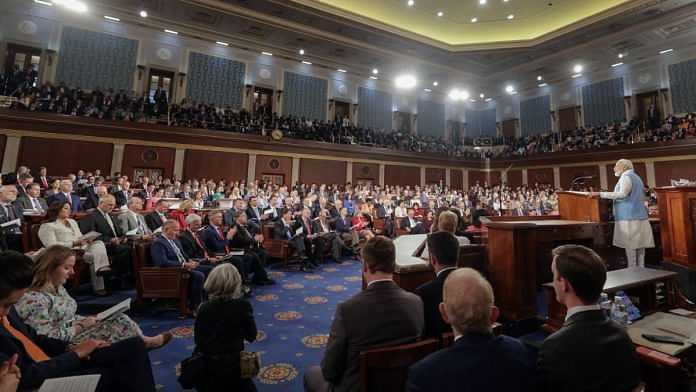New Delhi: Prime Minister Narendra Modi Thursday addressed the joint session of the US Congress. During his approximately one-hour-long speech, in which he referred to the partnership between India and the US as the “defining partnership of this century”, PM Modi received 53 rounds of applause and a record 15 standing ovations.
Speaking of Indo-US partnerships in technology and defence, PM’s speech emphasised on the growing relationship between the two countries, while also hinting at China’s threat in the Indo-Pacific.
PM Modi now figures on a small list of leaders to have addressed the US Congress more than once. Others include renowned figures like Winston Churchill and Nelson Mandela. He is also the sixth Indian prime minister to be given this platform.
He first addressed the US Congress in 2016 under the Barack Obama administration. Roughly 48 minutes, his speech then had received nine standing ovations and 33 rounds of applause, show media reports. Back then, he had highlighted how the two countries had overcome “hesitations of history” and a strong relationship between the two could “anchor peace”.
Before Modi, former PM Manmohan Singh, too, had received applause and cheers from US senators and congressmen 32 times during a 40-minute speech given in 2005, roughly a day after the two countries had signed the ‘India–United States Civil Nuclear Agreement’. On the agreement, which had ended a 34-year ban on nuclear trade with India, PM Singh had reportedly said: “Today, our relationship has overcome the hesitations of history. Comfort, candour and convergence define our conversations…. And, in this exciting journey, the US Congress has acted as its compass. You helped us turn barriers into bridges of partnership.”
Similarly, Atal Bihari Vajpayee had addressed the US Congress in September 2000. His speech came at a time when the US was concerned about India’s nuclear bomb tests in Pokhran in 1998, which cemented the country’s position as a nuclear power. PM Vajpayee had attempted to address American concerns by noting that India “does not wish to unravel your non-proliferation efforts” and called for the “shadow of hesitation” between the two countries to be removed.
Since India’s Independence in 1947, numerous other prime ministers have addressed the US Congress, including P.V. Narasimha Rao in 1994, who spoke of India-US relations being “on the threshold of a bold, new era” in the post-Cold War world.
Considered the first Indian PM to address the joint session of the US Congress, Rajiv Gandhi’s 25-minute-long address in 1985 is said to have received immense applause and laughter from US lawmakers, especially over his comparison of the two countries’ histories.
Roughly two years after Independence, the first Indian Prime Minister, Jawahar Lal Nehru had addressed the House and Senate separately — in the Committee on Ways and Means room and the Old Supreme Court Chamber, respectively — while the US Congress was under repair.
His 15-minute speech had come at a time when India-US relations were just beginning. However, Washington was critical of Nehru’s non-alignment policy as well as socialist views.
(Edited by Zinnia Ray Chaudhuri)
Also read: From unusual state dinner with Obama to ‘Howdy, Modi!’ — a look at Modi’s past 7 US visits



